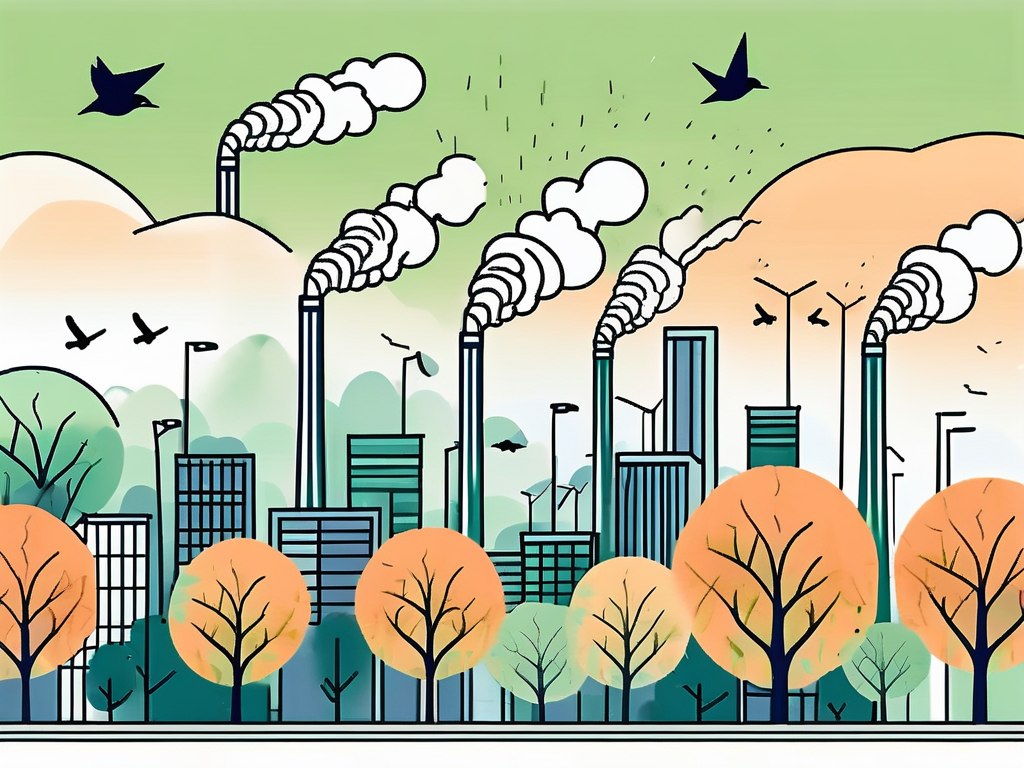Air quality is a vital aspect of our everyday lives, yet it often goes unnoticed and is easily taken for granted. Understanding the significance of air quality assessment is crucial not only for our health but also for the environment. This article aims to provide insight into the key concepts surrounding air quality, the impact of poor air quality on our health, the environmental consequences it brings, methods for assessing air quality, and strategies for improving air quality.
Understanding Air Quality: Key Concepts
What is Air Quality?
Air quality refers to the condition of the air we breathe in terms of its composition and level of pollutants. It is influenced by various factors, such as emissions from vehicles, industrial activities, natural sources, and weather conditions. Assessing air quality involves measuring pollutant concentrations and comparing them to established air quality standards or guidelines.

Monitoring air quality is essential for protecting public health and the environment. Poor air quality can lead to a range of health issues, from respiratory problems to cardiovascular diseases. Long-term exposure to air pollution has been linked to increased mortality rates and decreased life expectancy. Therefore, understanding and improving air quality is crucial for ensuring a sustainable and healthy future for all.
Factors Influencing Air Quality
Several factors contribute to the quality of the air we breathe. Anthropogenic activities, including burning fossil fuels, industrial emissions, and agricultural practices, release pollutants into the atmosphere. Natural factors such as volcanic eruptions, wildfires, and dust storms also affect air quality. Additionally, meteorological conditions, including temperature, humidity, wind speed, and atmospheric stability, play a crucial role in dispersing or trapping pollutants in the air.
Furthermore, the geographical location of an area can impact its air quality. Urban areas tend to have higher levels of air pollution due to increased human activities and traffic congestion. In contrast, rural areas may experience lower air pollution levels but can still be affected by pollutants transported from nearby urban centers. Understanding the complex interplay of these factors is essential for developing effective air quality management strategies and policies.
The Impact of Poor Air Quality on Health
Respiratory Issues Related to Air Pollution
Poor air quality, particularly high levels of pollutants, can have detrimental effects on respiratory health. Exposure to pollutants like particulate matter, sulfur dioxide, nitrogen dioxide, and ozone can lead to various respiratory conditions, including asthma, bronchitis, and chronic obstructive pulmonary disease (COPD). These pollutants irritate the respiratory system, leading to inflammation and decreased lung function.
Asthma, a chronic respiratory condition characterized by inflammation and narrowing of the airways, is exacerbated by poor air quality. When individuals with asthma are exposed to high levels of air pollutants, such as particulate matter, their symptoms can worsen, leading to increased episodes of wheezing, coughing, and shortness of breath. Long-term exposure to these pollutants can also increase the frequency and severity of asthma attacks, impacting the quality of life for asthma sufferers.
Long-term Health Effects of Poor Air Quality
Consistent exposure to polluted air can result in severe long-term health consequences. Studies have linked air pollution to an increased risk of cardiovascular diseases, lung cancer, stroke, and premature death. Moreover, vulnerable populations such as children, the elderly, and individuals with pre-existing respiratory or cardiovascular conditions are even more susceptible to the harmful effects of poor air quality.
Particulate matter, a mixture of solid particles and liquid droplets found in the air, can penetrate deep into the lungs and enter the bloodstream, causing systemic inflammation and damage to organs throughout the body. This can contribute to the development of cardiovascular diseases such as heart attacks, arrhythmias, and atherosclerosis. Additionally, long-term exposure to air pollution has been associated with an increased risk of developing lung cancer, particularly in individuals living in urban areas with high levels of traffic-related pollutants.
Environmental Consequences of Poor Air Quality
Effects on Wildlife and Ecosystems
Poor air quality doesn’t just impact humans; it also has significant repercussions on wildlife and ecosystems. Acid rain, for example, caused by sulfur and nitrogen emissions, can result in the acidification of water bodies, harming aquatic life. Additionally, air pollutants can damage forests, reduce crop yields, and disrupt the delicate balance of ecosystems.

Furthermore, poor air quality can lead to a decrease in biodiversity within ecosystems. Certain species are more sensitive to air pollution than others, leading to a decline in their populations. This disruption in the natural order can have cascading effects on the entire ecosystem, impacting food chains and overall ecosystem health.
Air Quality and Climate Change
Poor air quality and climate change are interconnected issues. The emission of greenhouse gases, such as carbon dioxide, from human activities contributes to climate change. These emissions often coincide with other air pollutants, leading to a compounded effect on air quality. Overcoming poor air quality is not only essential for our health but also for mitigating climate change and its associated impacts.
In addition, poor air quality can exacerbate the effects of climate change by contributing to the formation of smog and ground-level ozone. These pollutants not only have harmful effects on human health but also play a role in trapping heat in the atmosphere, further intensifying the warming of the planet. Addressing air quality issues is crucial in the fight against climate change and ensuring a sustainable future for all living beings on Earth.
Methods for Assessing Air Quality
Air Quality Monitoring Techniques
Various techniques are employed to monitor air quality and measure pollutant levels. Air quality monitoring stations, both fixed and mobile, utilize sophisticated instruments to collect data on pollutants such as particulate matter, nitrogen dioxide, ozone, and volatile organic compounds. These stations are strategically located in urban, industrial, and residential areas to capture a comprehensive picture of air quality across different environments. Fixed monitoring stations provide continuous data, while mobile units offer flexibility to investigate pollution hotspots or areas with limited accessibility.
In addition to stationary and mobile monitoring, remote sensing technologies play a crucial role in assessing air quality on a regional or global scale. Satellites equipped with sensors can detect pollutants in the atmosphere, providing valuable insights into pollution sources and transport patterns. Diffusion tubes, another monitoring tool, are often used for passive sampling in specific locations to assess pollutant levels over a longer period.
Interpreting Air Quality Data
Interpreting air quality data is crucial for understanding the severity of air pollution and its potential impacts. Air quality indices are often used to convert measured pollutant levels into an easy-to-understand format for the general public. These indices provide information on the air quality category, ranging from good to hazardous, and help individuals take necessary precautions to protect their health. By analyzing trends in air quality data over time, experts can identify pollution sources, evaluate the effectiveness of emission control measures, and forecast air quality conditions.
Improving Air Quality: Strategies and Solutions
Policies for Air Quality Improvement
Governments play a critical role in addressing air quality issues through the implementation of effective policies and regulations. These policies include setting air quality standards, promoting cleaner industrial practices, encouraging the use of cleaner fuels, investing in sustainable public transportation, and supporting the development of renewable energy sources. International collaborations and agreements also strive to tackle global air pollution challenges.

Furthermore, governments are increasingly focusing on implementing innovative policies such as carbon pricing mechanisms, low-emission zones in urban areas, and incentives for the adoption of electric vehicles. These measures aim to not only reduce harmful emissions but also promote a shift towards a more sustainable and environmentally friendly economy.
Role of Technology in Enhancing Air Quality
Advancements in technology have opened up new possibilities for improving air quality. Innovative solutions, such as emission control technologies for vehicles and industries, air purification systems for indoor environments, and real-time air quality monitoring devices for personal use, are being developed to help individuals, communities, and organizations actively contribute to reducing air pollution levels.
In addition to the mentioned technologies, emerging trends like artificial intelligence and big data analytics are being leveraged to optimize air quality management. These cutting-edge tools enable more accurate prediction of air pollution levels, efficient resource allocation for pollution control measures, and targeted interventions to address specific sources of pollution, thus paving the way for a smarter and more effective approach to air quality improvement.
In Conclusion
This comprehensive article has highlighted the importance of air quality assessment for our health and the environment. Understanding air quality, its impact on our health, and the environment allows us to take necessary actions to improve air quality. By employing effective monitoring techniques, interpreting air quality data, implementing policies, and embracing technological advancements, we can work towards a cleaner and healthier future for both ourselves and the planet.




